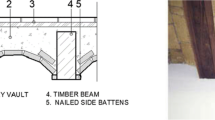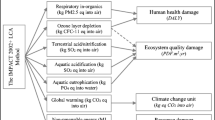Abstract
Purpose
In this study, the environmental performance of three newly developed materials for the conservation of built Cultural Heritage is preliminary evaluated by means of life cycle assessment (LCA). Although LCA has been adopted since many years in many fields, including the construction industry, still it is barely used the field of the Cultural Heritage conservation. Therefore, this paper aims to put a step forward to a wider use of the method for a more sustainable conservation of built heritage.
Methods
Cradle-to-gate approach was applied, which includes activities beginning with production of constituent and ancillary materials and concluding with the manufacturing of the product and its packaging. The functional unit was the production of 1 kg of the consolidant stored in a canister and ready to use. Ecoinvent database was used for the life cycle inventory of chemicals. This database was also taken into account to evaluate impacts related with energy (electricity) needs during manufacturing of the consolidants and production of polyethylene canisters (packaging material). The IMPACT 2002+ method was used to select the impact categories.
Results and discussion
The consolidants under investigation are calcium acetoacetate and two calcium alkoxides (calcium ethoxide and calcium isopropoxide). In the case of calcium acetoacetate consolidant, the highest environmental impact is related to the use of acetone dicarboxylic acid as raw material. Manufacturing process of the final product is not an energy-demanding process; hence, it is regarded as relatively clean from the environmental point of view. In the case of calcium ethoxide and calcium isopropoxide nanosuspensions, the innovative materials just recently developed for conservation purpose, manufacturing has been performed and optimized at a kg/lab scale; therefore, the results must be considered provisional. The two calcium alkoxides nanosuspensions show a relatively high environmental footprint that reflect the high consumption of ancillary materials, i.e. solid CO2 used to cool down the reaction and liquid ammonia as catalyst, currently released in the atmosphere.
Conclusions
The environmental footprint of calcium acetoacetate is relatively low showing that 1 kg of the consolidant is associated to 0.32 kg of CO2 equivalent emissions. In the case of two calcium alkoxides nanosuspensions, the global warming impact amounts to 198 kg (calcium ethoxide, 1 kg) and 132 kg (calcium isopropoxide, 1 kg) of CO2 equivalent emissions. Given the planned optimization of the industrial production currently under investigation, the environmental footprint of the two calcium alkoxides nanosuspensions is expected to reduce between 60 and 85%.





Similar content being viewed by others
References
Adams R, Chiles HM, Rassweiler CF (1925) Acetonedicarboxylic acid [glutaric acid, β-oxo]. http://www.orgsyn.org/demo.aspx?prep = cv1p0010, Accessed 26 May 2016
Ambrosi M, Dei L, Giorgi R, Neto C, Baglioni P (2001) Colloidal particles of Ca(OH)2: properties and applications to restoration of frescoes. Langmuir 17(14):4251–4255
Baglioni P, Giorgi R (2006) Soft and hard nanomaterials for restoration and conservation of cultural heritage. Soft Matter 2(4):293–303
Balliana E, Ricci G, Pesce C, Zendri E (2016) Assessing the value of green conservation for cultural heritage: positive and critical aspects of already available methodologies. In J Conserv Sci 7(1):185–202
Blundo DS, Ferrari AM, Pini M, Riccardi MP, Garcia JF, Fernandez del Hoyo AP (2014) The life cycle approach as an innovative methodology for the recovery and restoration of cultural heritage. Journal of Cultural Heritage Management and Sustainable Development 4(2):133–148
Brus J, Kotlík P (1996) Cracking of organosilicone stone consolidants in gel form. Stud Conserv 41(1):55–59
D’ Amato, R, Scalbi S, Giancristofaro C, Caneve L, Persia F (2014) Nanocomposites as protective layers for conservation of artistic stones: performance and LCA study. Quale sostenibilita per il restauro? 3 Scienza Beni Culturali, Bressanone 1–4 July 2014
De Schryver AM, Goedkoop MJ, Leuven RSEV, Huijbregts MAJ (2010) Uncertainties in the application of the species area relationship for characterisation factors of land occupation in life cycle assessment. Int J Life Cycle Assess15:682–691
EN 15804 (2012) Sustainability of construction works—environmental product declarations—core rules for the product category of construction products. European Committee for Standardization, Brussels
EN ISO 14040 (2006) Environmental management—life cycle assessment—principles and framework. International Organization for Standardization, Geneva
EN ISO 14044 (2006) Environmental management—life cycle assessment—requirements and guidelines. International Organization for Standardization, Geneva
European Commission (2015) Getting cultural heritage to work for Europe. Report of the Horizon 2020 Expert Group on Cultural Heritage. http://bookshop.europa.eu/en/getting-cultural-heritage-to-work-for-europe-pbKI0115128/;pgid=Iq1Ekni0.1lSR0OOK4MycO9B0000Qww3nZS9;sid=rhQTO8XC33wTP5KStMONnKfn43cNSWcB0kQ=?CatalogCategoryID=ANIKABstUgUAAAEjCJEY4e5L. Accessed 2 June 2016
Favaro M, Mendichi R, Ossola F, Russo U, Simon S, Tomasin P, Vigato PA (2006) Evaluation of polymers for conservation treatments of outdoor exposed stone monuments. Part I: photo-oxidative weathering. Polym Degrad Stab 91:3083–3096
Favaro M, Mendichi R, Ossola F, Simon S, Tomasin P, Vigato PA (2007) Evaluation of polymers for conservation treatments of outdoor exposed stone monuments. Part II: photo-oxidative and salt-induced weathering of acrylic-silicone mixtures. Polym Degrad Stab 92:335–351
Favaro M, Tomasin P, Ossola F, Vigato PA (2008) A novel approach to consolidation of historical limestone: the calcium alkoxides. Appl Organomet Chem 22:698–704
Favaro M, Chiurato M, Tomasin P, Ossola F, El Habra N, Svensson I, Beckers E, Forrat Pérez VJ, Romero Sanchez MD, Bernardi A (2014) Calcium and magnesium alkoxides for conservation treatment of stone and wood in built heritage. In: Toniolo L, Boriani M and Guidi G (eds) Proceedings “Built Heritage: Monitoring Conservation Management”. Milano, 18–20 novembre 2013, Springer, 413–422. ISBN: 978-3-319-08532-6
Ferrari AM, Pini M, Neri P, Bondioli F (2015) Nano-TiO2 coatings for limestone: which sustainability for cultural heritage. Coatings 5:232–245
Guinée JB, Gorrée M, Heijungs R, Huppes G, Kleijn R, de Koning A, van Oers L, Wegener Sleeswijk A, Suh S, Udo de Haes HA, de Bruijn H, van Duin R, Huijbregts MAJ (2002) Handbook on life cycle assessment. Operational guide to the ISO standards, Kluwer Academic Publishers, Dordrecht
InfoMine (2011) Calcium metal: production, market and forecast in Russia and in the world. InfoMine Research Group, Moscow http://eng.infomine.ru/files/catalog/380/file_380_eng.pdf. Accessed 3 February 2016
Jolliet O, Margni M, Charles R, Humbert S, Payet J, Rebitzer G, Rosenbaum R (2003) IMPACT2002+: a new life cycle impact assessment methodology. Int J Life Cycle Assess 8:324–330
Luo Y, Xiao L, Zhang X (2015) Characterization of TEOS/PDMS/HA nanocomposites for application as consolidant/hydrophobic products on sandstones. J Cult Herit 16(4):470–478
Melo MJ, Bracci S, Camaiti M, Chiantore O, Piacenti F (1999) Photodegradation of acrylic resins used in the conservation of stone. Polym Degrad Stab 66:23–30
Mosquera MJ, de los Santos DM, Montes A, Valdez-Castro L (2008) New nanomaterials for consolidating stone. Langmuir 24:2772–2778
Natali I, Tomasin P, Becherini F, Bernardi A, Ciantelli C, Favaro M, Favoni O, Forrat Pérez VJ, Olteanu ID, Sanchez M, Vivarelli A, Bonazza A (2015) Innovative consolidating products for stone materials: field exposure tests as a valid approach for assessing durability. Heritage Science 3:6. doi:10.1186/s40494-015-0036-3
Nuss P, Eckelman MJ (2014) Life cycle assessment of metals: a scientific synthesis. PLoS One 9(7):1–12. doi:10.1371/journal.pone.0101298
Ortiz O, Castells F, Sonnemann C (2009) Sustainability in the construction industry: a review of recent developments based on LCA. Constr Build Mater 23(1):28–39
Ossola F, Tomasin P, De Zorzi C, El Habra N, Chiurato M, Favaro M (2012) New calcium alkoxides for consolidation of carbonate rocks. Influence of precursors’ characteristics on morphology, crystalline phase and consolidation effects. New J Chem 36:2618–2624
Price CA, Doehne E (eds) (2010) Stone conservation: an overview of current research. Second edition. Getty conservation institute, Los Angeles (USA). http://www.getty.edu/conservation/publications_resources/pdf_publications/pdf/stoneconservation.pdf. Accessed 26 May 2016
Ropret P, Legan L, Retko K, Špec T, Pondelak A, Škrlep L, Sever Škapin A (2016) Evaluation of vibrational spectroscopic techniques for consolidantsʼ penetration depth determination. J Cult Herit. doi:10.1016/j.culher.2016.07.004
Sabbioni C, Brimblecombe P, Cassar M (eds) (2012) The atlas of climate change impact on European cultural heritage: scientific analysis and management strategies. Anthem Press, London, p 160
Sassoni E, Naidu S, Scherer GW (2011) The use of hydroxyapatite as a new inorganic consolidant for damaged carbonate stones. J Cult Herit 12:346–355. doi:10.1016/j.culher.2011.02.005
Sassoni E, Franzoni E, Pigino B, Scherer GW, Naidu S (2013) Consolidation of calcareous and siliceous sandstones by hydroxyapatite: comparison with a TEOS-based consolidant. J Cult Herit 14(3):e103–e108
Scheerer S, Ortega-Morales O, Gaylarde C (2009) Microbial deterioration of stone monuments an updated overview. Adv Appl Microbiol 66:97–139
Selwitz C (1992) Epoxy resins in stone consolidation. Research in conservation 7. The Getty Conservation Institute, Los Angeles, (USA). http://getty.edu/conservation/publications_resources/pdf_publications/pdf/epoxyresins.pdf. Accessed 26 May 2016
Siedel H, Siegesmund S (2011) Characterisation of stone deterioration on buildings. In: Siegesmund S, Snethlage R (eds) Stone in architecture: properties, durability, 4th edn. Springer, Berlin-Heidelberg, pp 347–410
Sierra-Fernandez A, Gomez-Villalba LS, Rabanal ME, Fort R (2014) New consolidant product based on nanoparticles to preserve the dolomitic stone heritage. In: Candelera R (ed) Science. Technology and Cultural Heritage, Taylor & Francis Group, London, pp 139–144
Škrlep L, Pondelak A, Sever Škapin A (2014) Method for reinforcing porous construction materials and use calcium acetoacetate solution to this aim: international application no. PCT/SI2014/000028. [S. l.]: Europen Patent Office (EPO) (ISA/EP)
Steiger M, Charola AE, Sterflinger K (2011) Weathering and deterioration. In: Siegesmund S, Snethlage R(Eds), Stone in architecture: properties, durability, 4th ed. Springer, Berlin-Heidelberg, pp 227–316
Warscheid T, Braams J (2000) Biodeterioration of stone: a review. International Biodeterioration & Biodegradation 46/4:343–368
Acknowledgements
We would like to acknowledge the European Commission’s financial support for the NANOMATCH project (FP7/2011-2014, grant agreement no. 283182) and HEROMAT project (FP7/2011-2015, project reference: 282992).
Author information
Authors and Affiliations
Corresponding author
Additional information
Responsible editor: Ivan Muñoz
Janez Turk and Matteo Chiurato contributed equally to this article.
Electronic supplementary material
.
ESM 1
(DOCX 45.5 kb)
Rights and permissions
About this article
Cite this article
Turk, J., Pranjić, A.M., Tomasin, P. et al. Environmental performance of three innovative calcium carbonate-based consolidants used in the field of built cultural heritage. Int J Life Cycle Assess 22, 1329–1338 (2017). https://doi.org/10.1007/s11367-017-1260-8
Received:
Accepted:
Published:
Issue Date:
DOI: https://doi.org/10.1007/s11367-017-1260-8




